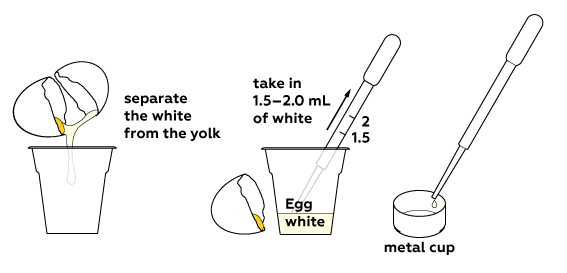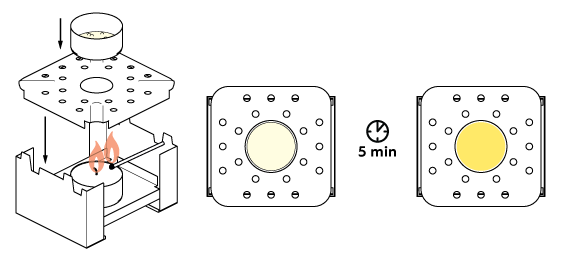Yolk from white
Conduct the qualitative analysis to find proteins in egg white!

Reagents
Safety
- Put on protective gloves and eyewear.
- Conduct the experiment on the plastic tray.
- Keep a bowl of water nearby during the experiment.
- Do not allow chemicals to come into contact with the eyes or mouth.
- Keep young children, animals and those not wearing eye protection away from the experimental area.
- Store this experimental set out of reach of children under 12 years of age.
- Clean all equipment after use.
- Make sure that all containers are fully closed and properly stored after use.
- Ensure that all empty containers are disposed of properly.
- Do not use any equipment which has not been supplied with the set or recommended in the instructions for use.
- Do not replace foodstuffs in original container. Dispose of immediately.
- In case of eye contact: Wash out eye with plenty of water, holding eye open if necessary. Seek immediate medical advice.
- If swallowed: Wash out mouth with water, drink some fresh water. Do not induce vomiting. Seek immediate medical advice.
- In case of inhalation: Remove person to fresh air.
- In case of skin contact and burns: Wash affected area with plenty of water for at least 10 minutes.
- In case of doubt, seek medical advice without delay. Take the chemical and its container with you.
- In case of injury always seek medical advice.
- The incorrect use of chemicals can cause injury and damage to health. Only carry out those experiments which are listed in the instructions.
- This experimental set is for use only by children over 12 years.
- Because children’s abilities vary so much, even within age groups, supervising adults should exercise discretion as to which experiments are suitable and safe for them. The instructions should enable supervisors to assess any experiment to establish its suitability for a particular child.
- The supervising adult should discuss the warnings and safety information with the child or children before commencing the experiments. Particular attention should be paid to the safe handling of acids, alkalis and flammable liquids.
- The area surrounding the experiment should be kept clear of any obstructions and away from the storage of food. It should be well lit and ventilated and close to a water supply. A solid table with a heat resistant top should be provided
- Substances in non-reclosable packaging should be used up (completely) during the course of one experiment, i.e. after opening the package.
FAQ and troubleshooting
Check that the candle is burning well and wait for 2 more minutes.
Step-by-step instructions
Prepare the egg white. It consists mostly of water and ovalbumin protein. We won’t need the yolk for this experiment.

In order to make a “yolk” out of an egg white, we’ll need nitric acid. Let’s synthesize it with a reaction between calcium nitrate Ca(NO₃)₂ and sodium hydrogen sulfate NaHSO₄.

The reaction with nitric acid is a qualitative test for the detection of proteins. The reaction requires heating.

Adding sodium carbonate will create basic conditions which boost the color.

Expected result
With the help of nitric acid, the egg white turns yellow and resembles an egg yolk. When sodium carbonate is added to the “yolk”, it turns orange.
Disposal
Dispose of solid waste together with household garbage. Pour solutions down the sink. Wash with an excess of water.
Scientific description
What happens to the egg white?
Chemically, an egg white is made out of protein molecules. Proteins are very large molecules with a complex structure. Proteins are made of many individual amino acids. The individual amino acids are linked together to form chains. These chains are twisted together into a complex spiral or knot. However, as soon as a molecule of protein meets with a molecule of nitric acid HNO3 – this complex structure starts to unwind and forms a yellow-colored yolk-like mass. This is how an egg white “turns into a yolk”. This experiment is very practical. Chemists use this reaction to determine the presence of protein in different samples. It is called the xanthoproteic test.
How is nitric acid produced in this experiment?
Nitric acid forms when we mix sodium hydrogen sulfate with calcium nitrate, according to the following reaction:
NaHSO4 + Ca(NO3)2 → CaSO4 + NaNO3 + HNO3
Why does the “yolk” become orange when sodium carbonate is added?
When sodium carbonate Na2CO3 dissolves, it creates a basic medium. When a basic solution is added to the “yolk” obtained in the previous part of the experiment, the “yolk” transforms into its basic form which has an orange color.